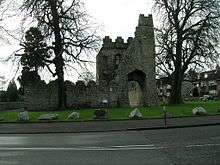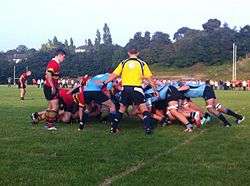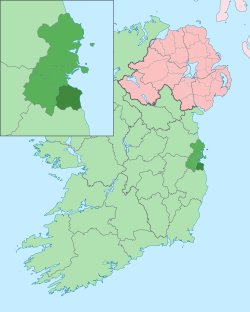Monkstown, County Dublin
Monkstown (Irish: Baile na Manach), historically known as Carrickbrennan (Irish: Carraig Bhraonáin), is a suburb in south Dublin, located in Dún Laoghaire–Rathdown, Ireland. It is on the coast, between Blackrock and Dún Laoghaire.
Monkstown Baile na Manach | |
|---|---|
Suburb | |
 Monkstown Location in Dublin  Monkstown Monkstown (Ireland) | |
| Coordinates: 53°17′38″N 6°09′13″W | |
| Country | Ireland |
| Province | Leinster |
| County | Dún Laoghaire–Rathdown |
| Government | |
| • Dáil Éireann | Dún Laoghaire |
| • EU Parliament | Dublin |
| Population (2006) | |
| • Urban | 6,369 |
| Time zone | UTC±0 (WET) |
| • Summer (DST) | UTC+1 (IST) |
| Eircode (Routing Key) | A94 |
| Area code(s) | 01 (+3531) |
| Irish Grid Reference | O221292 |
The lands of the Carrickbrennan estate form the greater part of the civil parish of Monkstown.
History
A church was built at Carrickbrennan (as Monkstown was then known) before the 8th century, and dedicated to Saint Mochonna, bishop of Inispatrick or Holmpatrick by Skerries. The grange of Carrickbrennan, otherwise Monkstown, was granted by the King to the Cistercian monks of Saint Mary's Abbey, Dublin, in 1200. The monks built their grange near to the church, and the village grew up around it. The lands of which it was a part extended as far south as Bulloch harbour on the outskirts of Dalkey, where the monks constructed a fishing harbour protected by a castle.[1]
In 1539, King Henry VIII awarded the Monkstown lands to Sir John Travers, Master of the Ordnance in Ireland. John Travers lived in his Castle at Monkstown from 1557 to his death in 1562 (he is buried in the Carrickbrennan Graveyard) when the property fell to James Eustace 3rd Viscount Baltinglass through his marriage to Mary Travers. In 1580, the Castle was used as a rebellion stronghold, after which it was awarded to Sir Henry Wallop, Vice-Treasurer of Ireland. The lands were later returned to Mary, the widowed Lady Baltinglass, who later married Gerald Alymer. On her death in 1610 the Castle was transferred to the Chevers family through the marriage of Mary Travers's sister Catherine to John Chevers, and the property passed directly to his second son Henry Chevers, who married Catherine, daughter of Sir Richard Fitzwilliam. Henry and Catherine Chevers lived here with their four children (Walter, Thomas, Patrick, Margaret).
Upon the death of Henry in 1640, the castle and lands were passed to Walter Cheevers. Walter and family received command to vacate Monkstown in 1653 by the Cromwellian Commissioners, and transplanted to Killyan, County Galway. In 1660, Walter Chevers was restored to his estate at Monkstown Castle, until his death in 1678. His death occurred on the 20th day of December 1678, and he was buried at Mountoun (Monkstown), two days later on 22nd.[2] The Shivers family of America trace their lineage to Thomas Chevers brother of Walter Chevers of Monkstown, through the Cromwellian warrant, authorized on 26 November 1653 for Captain John Whittey to transport the Thomas Chevers family to America.
Monkstown was later purchased by the Archbishop of Armagh, Michael Boyle, and his son Murrough Boyle, 1st Viscount Blesington enlarged the castle, making it one of the finest residences.
Until about 1800, Monkstown was a rural area of open countryside, dotted here and there with large houses owned by the merchants of Dublin. The Monkstown Church (Church of Ireland) had been built – but was smaller than the present church.
The two small local rivers met in the area now called Pakenham Road. The river known as Micky Briens originated in Sallynoggin. A lake beside Monkstown Castle had one small island. The coastline was ragged and rocky, with a harbour stretching over 100 yards inland at the mouth of the aforementioned rivers, adjacent to the area now occupied by the West Pier. Dún Laoghaire (then called Dunleary, and later Kingstown) was then a small group of houses in the area of the Purty Kitchen, and the present area of Dún Laoghaire was an area of rocky outcrops and later, quarries.
Wednesday, 18 November 1807 a night of disasters in southern Dublin. In an horrific storm, two sailing ships, the Rochdale and the Prince of Wales were blown on to the rocks, one at Seapoint and the other at Blackrock. About 400 lives in total were lost on that night, many of them washed up on the shore at Monkstown. The disaster was one of the factors which led to the building of Dún Laoghaire Harbour. Most of the victims were buried in Carrickbrennan Churchyard.
The building of Dún Laoghaire harbour gave an impetus to the area, and Montpelier Parade was the first of many terraces built in the area. The coming of the railway in 1837 had a much greater impact. Firstly, it changed the topology of the coast, and secondly, it led to Monkstown becoming a commuter suburb of the city of Dublin. Most of the houses along Monkstown Road and the avenues north of that road were constructed over the next 30 years. The maps of 1870 show this phase completed, but the rest of Monkstown consists of mansions surrounded by extensive gardens.
.jpg)
For the following 50 years there was little change. The post-war developments of Castle Park, Richmond, Windsor, etc. and the more recent developments of Brook Court, Monkstown Valley, and Carrickbrennan Lawn mean that there is little opportunity for further development.
The diaries of the Rev John Thomas Hynes (1799–1868), a Catholic bishop who retired to Monkstown in 1861-68, provide a valuable insight into daily life in Monkstown in that period. Hynes lived at Bloomwood, Monkstown Avenue (later renamed as Carrickbrennan Road), and later moved to Uplands, The Hill, Monkstown. The Hynes Diaries recount such details as the coming of gas lighting, the postal and travel facilities, church affairs, and lots of local gossip. The Hynes diaries are now preserved in Melbourne, but the full text has been made available online.[3]
Documentary references
- Monkstown is first mentioned in 1450; Tenants Cistercians at Carrickbrennan, Villa Monachorum.
- Carrickbrennan, or "Carigbrenna", features on the 1598 map "A Modern Depiction of Ireland, One of the British Isles"[4] by Abraham Ortelius.
- Records of the Abbey of the Blessed Virgin Mary 1640.
- Forfeiting Proprietors under the Cromwellian Settlement 1657.
- In James Joyce's "The Dead," Gabriel Conroy and his wife Gretta live in Monkstown.
Noted buildings


Monkstown has two old established churches, Saint Mary's Church of Ireland (1831) and Saint Patrick's Catholic Church (1866), both on Carrickbrennan Road. Saint John's Church, located at Gamble's Hill, was originally constructed as a Church of Ireland Church in the 1860s but was renovated and re-consecrated by the Society of Saint Pius X after 1985. Buildings of other religious denominations include the Kingdom Hall of the Jehovah's Witnesses at Monkstown Farm, and the Meeting Hall of the Society of Friends at the junction of Packenham Road and Carrickbrennan Road. There is also the Friends Burial Ground (Quaker) located at Temple Hill just off Monkstown Road.
Monkstown Castle, which was probably built in the 12th or 13th centuries, was erected by the monks of the abbey of the Virgin Mary, near Dublin.
Monkstown is also noted for its coastline, which is home to a number of historical buildings of the Victorian, Georgian and Edwardian periods. One of the most notable buildings of the Salthill and Monkstown area is a Martello Tower, located at Seapoint beach.
Transport
The DART stations of Seapoint and Salthill and Monkstown serve the area.
Dublin Bus serve the area with routes 7,7a,7n and 63.
An Aircoach service starting in Dalkey links the area with Dublin Airport 24 hours a day.
Sports
Monkstown Lawn Tennis Club was founded in 1877. It was the first tennis club in Ireland.
Monkstown Football Club was founded in the village in 1883 before moving to Sandymount in 1901.
Monkstown (Dublin) Boxing Club was founded in 2004, their gym is situated in the newly built Mounttown Community Centre in Fitzgerald Park, in the Monkstown Farm Area.
Farm Utd Football Club was formed in 1935, and uses part of the Monkstown Community Centre as its dressing rooms.
Monkstown also has a Brazilian jiu-jitsu club Ribeiro Jiu Jitsu Ireland. Their gym is situated in the Mounttown Industrial Estate.
Monkstown also has a thriving hockey club, Monkstown Hockey Club based in the Rathdown School.
Culture
Comhaltas Ceoltóirí Éireann, an organisation promoting Irish culture (particularly Irish traditional music), has its headquarters in Monkstown, as does BirdWatch Ireland.
Monkstown had for decades a puppet theatre, the Lambert Puppet Theatre, a family-run business, which for many years hostsed an international puppet festival. It also used to appear on national television, for RTÉ. It closed some time after a severe arson episode.
There are several references to Monkstown and its wealthy residents in the Ross O'Carroll Kelly series.
Education
A multi-denominational primary school, Monkstown Educate Together National School (METNS), a fee paying junior and senior school Monkstown Park Junior School and CBC Monkstown Park, and Holy Family National School[5] are located in the Monkstown area. A Gaelscoil is also located in Monkstown, Scoil Lorcáin, teaching all classes through Irish.
St. Oliver Plunkett N.S is a school for children with a Specific Learning Difficulty (SLD). This school caters for children from a wide catchment area.

Christian Brother's College is based on the old estate of Charles Haliday at Monkstown Park. It consists of two schools; an Independent preparatory school with 200 students and a fee paying secondary school with more than 500 students. CBC caters for boys from junior infants through sixth year. The college recently completed a major development which saw existing buildings upgraded and a new extension built.[6]
Representation
Monkstown is part of the Dáil Éireann constituency of Dún Laoghaire.
Amenities
Monkstown has a number of restaurants, cafés and pubs which include Goggins Pub, FXBs The Pub, That's Amore, Bresson Restaurant, Siobheal Nic Eochaidh, and Avoca Food Market. Family owned shops and businesses in the area include Hewett Newsagents, Cosgrove's Pharmacy and the Carrick Hoover Centre.
People
- Malcolm Arnold
- D. J. Carey
- Tim Pat Coogan
- Chris de Burgh
- The Edge, guitarist of U2
- Howard Grubb (1844–31) was a designer and maker of telescopes. He lived at De Vesci Terrace, and from 1925, at 13 Longford Terrace, which now bears a plaque.[7]
- Helen Dillon (1940- ), one of Ireland's most famous gardeners, who moved from Ranelagh in 2016, and has now opened her new Dillon Garden
- Alfred Gresham Jones (1824?–1913) was an Irish architect who designed Merrion Hall on Merrion Street Lower, now the Davenport hotel, in 1862 and designed the villa Verona in Queen's Park in 1873. He lived at Queen's Park House from 1869–72, at Clifton Lodge on Seafield Ave 1873-76, at Villa Carlotta on Queen's Park 1886-88, and then emigrated to Australia.[8]
- Paul McGuinness
- Charles Mitchel - the first RTÉ television newsreader
- Cillian Murphy - actor[9]
- Bláthnaid Ní Chofaigh
- Sinéad O'Connor
- Peadar O'Donnell (1893–1986), Irish socialist republican revolutionary
- John O'Shea (humanitarian)
- William Parsons, 3rd Earl of Rosse (1800–64) lived at 1 Eaton Place, and built several telescopes, including the world's largest telescope in 1845, which remained the world's largest for the rest of the century. Using this telescope he saw and catalogued a large number of galaxies.[7]
- Richard Pigott (1835–89) lived at 7 De Vesci Terrace. He was an Irish journalist, best known for selling the Pigott forgeries.[7]
- Ryan Tubridy - presenter of The Late Late Show[10]
- Anthony Upton (1656–1718), judge of the Court of Common Pleas (Ireland), lived at Mountown House, in present-day Monkstown.[11]
- Eve Watkinson (1909 – 1999) was an Irish stage, film and television actress
- Nuala Carey
- Christy Moore
References
- "Monkstown". logainm.ie. Placenames Database of Ireland. Retrieved 7 October 2017.
- Funeral Certificate.
- Hynes, Diaries (PDF), AU: Unisa
- "A Modern Depiction of Ireland, One of the British Isles — Viewer — World Digital Library". www.wdl.org.
- Holy Family national school, IE: Scoil net.
- Christian Brother's College, IE, retrieved 7 February 2008
- Roche, Tom; Finlay, Ken (2003), Blackrock, Dun Laoghaire and Dalkey (Along the coast from Booterstown to Killiney).
- "Alfred Gresham Jones", The Directory of Irish Architects.
- "Cillian Murphy shells out €1.7m on home in Monkstown - Independent.ie".
- Lyons, Madeleine (16 September 2015). "Ryan Tubridy moves on from €1.275m Monkstown home: Presenter is downsizing from a restored Victorian he bought two years ago". The Irish Times. Retrieved 16 September 2015.
Meanwhile he says he plans to stay in the area close to the sea, and the Dart. Will he go for something completely different next time around? 'No, I would definitely go for old school with a modern twist again, but ... I'd prefer to find something where someone else has been kind enough to do all the work already'.
- Ball, F. Elrington The Judges in Ireland 1221-1921, London: John Murray, 1926; Vol. 2, p. 67
